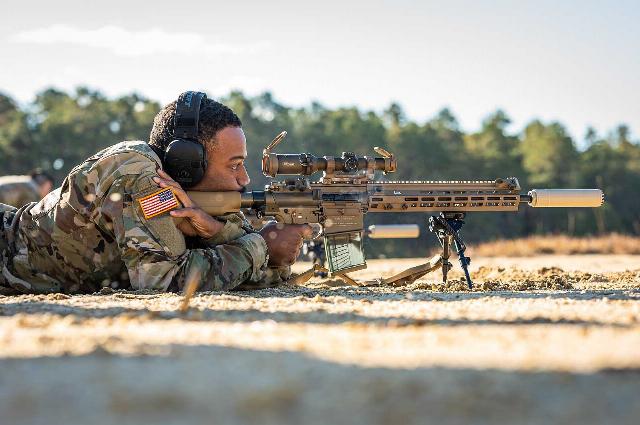So you want a suppressor?
Most Americans know of suppressors—usually misgendered as “silencers”—from the movies. In that medium, suppressors produce no more sound than a dainty sneeze, and are used only by assassins and tier 1 special operators. It’s all very dramatic, but reality, as usual, is different.

Graphic: 44th IBCT M110A1 Range. Wikimedia Commons. Org. Public Domain.
Suppressors were invented in 1902 by MIT graduate, Hiram Percy Maxim, son of Sir Hiram Stevens Maxim of machinegun fame. Patented in 1909, his suppressors quickly became popular. One graced Teddy Roosevelt’s Winchester model 1894 lever action rifle.
However, in 1934, the National Firearms Act was passed, imposing licensing and registration requirements on automatic arms and suppressors, including a $200 dollar, non-transferrable, tax. In 1934, this amounted to a substantial portion of the average American’s annual income, which stalled suppressor development and sales for nearly half a century.
However, in recent years, interest in suppressors has boomed, certainly in reaction to Barack Obama, Hillary Clinton, Joe Biden, Democrats/socialists/communists (D/s/cs) in general, and their gun banning intentions. Circa 2021, just under three million were in private hands. More currently by 2023, there were nearly four million. That number has surely increased since, as circa 2021 applications/approvals were rising by as much as 17% per year, though the approval process can take up to a year.
The most important advantage of suppressors is preventing permanent hearing damage. They reduce sound pressure levels below the threshold of hearing damage, no more, and slightly change the timbre of gunshots, but suppressed gunshots are still recognizable as gunshots. Consider this, from the NRA-ILA, via The Truth About Guns:

Graphic: The Truth About Guns. Screenshot.
Many suppressor dealers and manufacturers, such as The Silencer Shop, and Silencer Central, have processes for filing and expediting federal paperwork (NFA Form 4). You pay for the suppressor and federal tax, and they do the rest, including delivering the suppressor to your door when all federal paperwork has been approved.
Suppressors are relatively simple devices with no moving parts. With some exceptions, they are round tubes of various diameters and lengths, hence the common term “can.” A great many handguns and rifles now come standard with barrels threaded to accept suppressors.
But who would want a suppressor? Hunters, target shooters, anyone–-like police officers and the military–-that might have to shoot indoors, which would include any law-abiding citizen that might have to use their handgun indoors or outdoors for home protection. They are a very useful, hearing saving accessory. The only reason they are not more widely distributed among the population, and remain relatively expensive is because of the onerous, lengthy and relatively expensive federal registration/taxation requirements. Circa 2024, increased mistrust of government—few, including other law enforcement agencies, have ever trusted the BATF—is also a factor. As even the BATF notes, suppressors are rarely used in crimes, no more than a tiny fraction of a single percent, and even that is conjecture. Criminals don’t use them because they commonly double the length of a handgun, making it much harder to conceal.
Currently, only eight states, all blue, outlaw suppressors. Virtually all the rest allow them for hunting.
Suppressors control the gas produced when a cartridge is fired. Much of the noise of shooting comes from the supersonic crack of the bullet, and the propellant gases escaping the muzzle at supersonic velocity, disturbing the air at the muzzle. This is also the source of muzzle flash. Dampening the report is therefore a matter of controlling–-trapping and dissipating–-as much of the gas as possible. Reducing the velocity of bullets to subsonic levels, with heavier bullets and less powder, also helps to reduce the perceived sound of firing.
Gas control is accomplished by means of internal baffles, a number of individual chambers that bleed off and decelerate/dissipate the gasses. However, rapid fire quickly heats any suppressor. Not only is such rapid heating hard on shooters, it’s also hard on suppressors. To deal with these issues, suppressors are commonly made of aluminum, stainless steel, or even titanium, which, because it is hard to machine, is much more expensive.
Anti-liberty/gun cracktivists want to outlaw suppressors, but tend to focus more on outlawing nonexistent “assault weapons,” and “high capacity” magazines. Even when Republicans controlled the Congress and White House, their leadership refused to remove federal tax and paperwork requirements, claiming “it wasn’t the right time.” It’s unlikely they’ll ever think the time right. Liberty lost is virtually never regained.
Unlike most firearms, suppressors are in federal data bases, so should government ever decide to confiscate them, the number of suppressors and guns lost in tragic boating accidents would reach epic proportions. Still, it is possible to own a suppressor, and they do provide real health and safety benefits.
Mike McDaniel is a USAF veteran, classically trained musician, Japanese and European fencer, life-long athlete, firearm instructor, retired police officer and high school and college English teacher. He is a published author and blogger. His home blog is Stately McDaniel Manor.
Read More: So you want a suppressor?

